Growing Turkish tobacco from seeds: instructions for beginners, features of the variety
The smoking properties of tobacco were known long before our era, but since then the plant has undergone numerous changes. Ardent supporters of a healthy lifestyle reject tobacco, considering it the main enemy for the human body, but nothing is clear in the world. The healing properties of tobacco are known - it is even used in official medicine. The plant is used to control pests on the site, and housewives add tobacco leaves to cooking, giving dishes a unique rich taste. For this reason, tobacco crops are in demand among gardeners around the world.
Turkish tobacco – unique variety, capable of satisfying any connoisseur of tobacco products and hookah smoking. We will tell you in detail about the nuances of tobacco growing and reveal the secrets of productivity.
What type of tobacco is this?
This is an annual plant that at home grow through seedlings. Its seedlings are large, growing more than 1 m in length. Initially, the Turkish variety was bred only in Turkey, Greece and Macedonia, but gradually it conquered other regions.

History of origin and development
The history of tobacco smoking dates back to long before our era. Smoking pipes were found during excavations dating back to Ancient Egypt. It is known that the ancient Greek scientist Herodotus described in his writings the Scythian habit of inhaling the smoke of burning leaves.
Many researchers associate the beginning of smoking with the culture of Native Americans - it is known that the Indians chewed tobacco and smoked the so-called peace pipes. Subsequently, this habit turned into a cult tradition.
Christopher Columbus spread tobacco plants all over the world: smoking Indians were the first natives encountered on new lands. Columbus brought the leaves of an unusual plant to Europe. The name "tobacco" comes from the island of Tobago, where the plant grew naturally.
Today, tobacco cultivation is practiced all over the world.
Features, characteristics and description
Tobacco is a cultivated plant and requires some care.
The Turkish variety differs from other species in its medium-sized leaves, which are dried only in the sun.
The stem is elongated, with many medium-sized leaves of light green color. After the flowers fall, small boxes are formed - fruits, inside of which there are many small seeds. They are collected for the next sowing.
The color of the dried leaves acquires a greenish-yellow or golden-orange hue, which is not typical for other varieties. It has a sweetish, pleasant aroma; some note chocolate notes in the taste.
They are used primarily for preparing tobacco mixtures and for hookah smoking. Turkish pipe tobacco has become widespread; when smoked, it produces thick white smoke and has chocolate notes in its flavor.
Interesting fact. Numerous studies confirm the analgesic properties of tobacco, which allows the plant to be used for medicinal purposes.
The leaves of the tobacco plant are widely used in cooking as a decoration for various dishes and an excellent addition to the taste sensations in the preparation of meat products.
Reference! Ready-made Turkish tobacco from Tanya is intended for hookah. This is a high-quality smoking mixture that is in high demand due to its sweetish honey aroma.
To be fair, it must be said that ready-made Turkish tobacco does not contain mmc, that is, mephedrone is an empathogen and psychostimulant, which is added to modern cigarettes in minute quantities. Often, hookah products do not even contain nicotine; they include: marinade (molasses and honey), flavorings, glycerin and preservatives.
Where to buy and how much do seeds cost?
Turkish tobacco seeds are sold in any specialized store at affordable prices. The price varies between 130-180 rubles per package. One package contains at least 100 seeds.
Reference! Seed material saves germination for several years.
Features of cultivation
So, tobacco does not grow by itself. First, the seeds are sown for seedlings and then transplanted into the ground. You will find everything about growing Turkish tobacco at home in this section.
Condition requirements
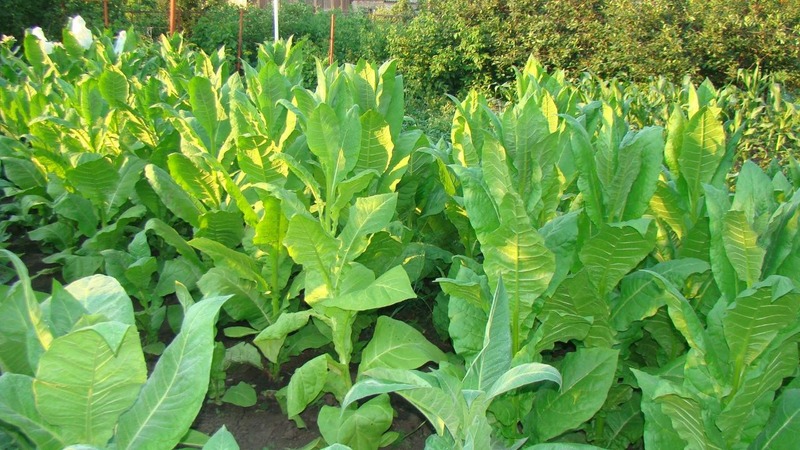
Tobacco is a heat-loving crop, so seed material is sown directly into the ground only in the southern regions. It is believed that the harvest will be richer if grown through seedlings. But if southerners have the opportunity to propagate the crop using the seedless method, then residents of other regions are forced to use only the seedling method.
For sowing, prepare planting containers and light fertile soil.During the seedling period, seedlings are provided with lighting, moderate watering and fertilizing. The seedling period lasts no more than 45 days.
Sowing and caring for seedlings
Before sowing, the seed material is germinated for 2-3 days. To do this, wrap it in gauze and place it at the bottom of a glass container. The container is left in a warm place.
The soil is prepared from humus and washed river sand in a ratio of 3:1. Sand acts as a leavening agent and gives lightness to fertile humus.
The sprouted seeds are mixed with sand and laid out on the surface of the prepared soil mixture, which is well moistened in advance. The grains are covered with the remaining soil on top and lightly moistened with warm, settled water from a spray bottle. Then they are covered with film to create a greenhouse effect. The temperature in the room until germination is maintained at 24-26°C.
Seedlings do not like picking and do not grow for a long time after this procedure. Therefore, individual planting containers are chosen so as not to injure young plants.
Important! Containers and soil are subject to mandatory disinfection to destroy pathogens. For disinfection, use a weak solution of potassium permanganate.
When shoots appear, remove the film and place the containers on the windowsill. The duration of daylight should be at least 12 hours. If there is a lack of natural light, additional lighting is installed, otherwise the sprouts will begin to stretch upward, which will lead to a weakening of the stem.
Water as needed with warm, settled water from a shallow watering can, preventing the soil from drying out. Excess moisture poses a risk of developing fungal diseases.Seedlings are ventilated twice a day, but without drafts, which will have a detrimental effect on the seedlings.
When two true leaves are formed, the room temperature is reduced to 20°C.
The seedlings are first fed a week after the formation of two true leaves. As a fertilizer, 20 g of sodium sulfate and 30 g of ammonium nitrate are dissolved in one bucket of water.
A week before transplanting into the ground, the seedlings begin to harden off by taking the containers out into the open air during the daytime. The initial period of stay on the street is no more than an hour. Every day, the time spent outdoors is increased by 30-40 minutes.
The seedlings are ready for transplanting as soon as the seedlings grow to 15 cm and form six true leaves.
Transplantation into the ground
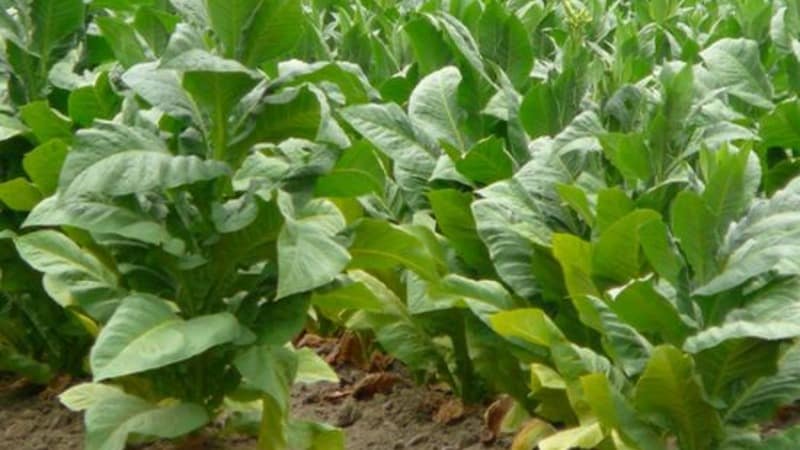
After the threat of frost has passed, replanting begins. Two days before this, the seedlings are not watered and moistened abundantly right before planting.
The beds are prepared in advance, the soil is dug up and wood ash is added. The distance of the holes from each other is at least 50 cm. Place a little rotted mullein at the bottom of the hole and fill it with water. After transplanting, the holes are filled first with moistened soil and then with dry soil. Tobacco is most often planted along the fence or in corner places where there is no stagnation of moisture. The plant does not like wetlands and direct sunlight.
Further care of tobacco
For full development, the plant is provided with proper watering, weeding, loosening and timely fertilizing.
If the plant can tolerate a short-term lack of moisture, its excess will lead to the death of the crop. Therefore, water moderately, avoiding the soil from drying out if possible. The main indicator of the need for watering is the foliage of seedlings.They should always remain green and not turn yellow or fade.
After watering, the beds are loosened and weeds with roots are removed. Loosening promotes the penetration of oxygen to the roots, which is necessary for the growth of seedlings. Weeds absorb numerous nutrients and transmit a variety of diseases. These are extremely undesirable neighbors for tobacco plants.
A few days after transplantation, the first feeding is carried out. The main fertilizer for tobacco is minerals containing nitrogen, potassium and phosphorus. The second feeding is applied three weeks after the first. And the third time the crop is fertilized three weeks after the second feeding.
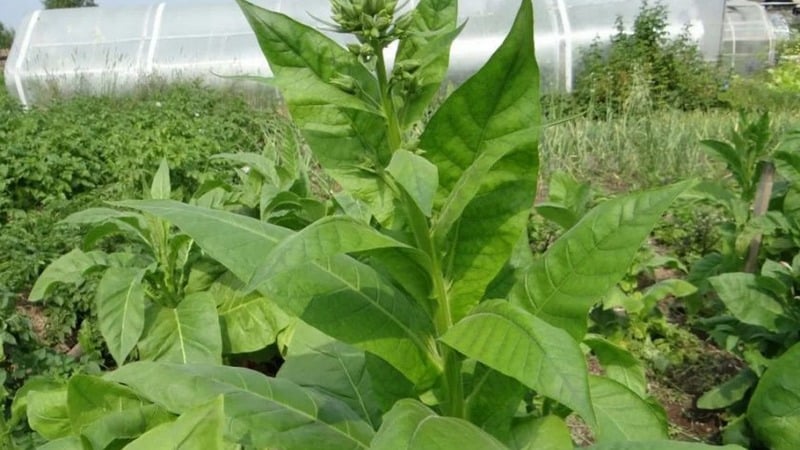
Important! All fertilizing is applied after abundant watering.
During growth, seedlings grow a large number of stepsons, which take away useful substances. These are unnecessary lateral shoots: if they are not removed, they will lead to thickening of the plantings. In addition, the main foliage will be poorly supplied with nutrition due to the growth of stepsons. Therefore, they are carefully removed, and the cut areas are sprinkled with ash.
To limit the growth of seedlings, topping is carried out, that is, the top of the head is pinched, thereby limiting further growth. Without pinching, seedlings grow up to 2 m.
Disease and pest control
The crop is immune to many diseases, but there is a risk of downy mildew and powdery mildew. These are fungal diseases that develop in moist environments. Therefore, it is important to maintain moderate watering. Preventive measures also include loosening and weeding. To combat fungal diseases, use Benlata powder and the drug Zineba.
Tobacco mosaic is a viral disease that cannot be treated. Diseased plants are burned.As a preventive measure, the bushes are sprayed with a formaldehyde solution.
Among the pests that pose a threat to tobacco plantings are tobacco thrips and wireworm – the larva of the click beetle. Insects settle on the leaves, sucking the juices out of them, as a result of which the plants wither. To combat thrips, use the drug "Rogor" or "Metathion", and get rid of wireworms using "Hexachloran".
For prevention purposes, it is imperative to remove weeds with roots, since the life cycle of most pests takes place in it.

Harvesting
As soon as the leaves stop growing, harvesting begins. At this point, the leaves gain a special density, which indicates the quality of the product. Collecting tobacco leaves in the evening, starting from the lowest ones, so as not to damage the leaf blades.
Further processing
The harvested crop is not immediately ready for use. For intended use, the leaves are subjected to further processing.
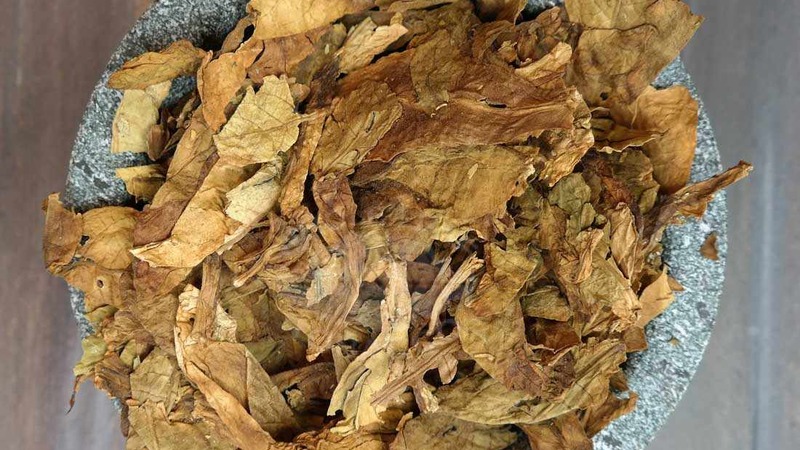
Drying and fermentation
The leaves of this variety can only be dried under sunlight. The procedure combines two processes: drying and fermentation. Fermentation - This is the breakdown of nutrient molecules, without oxidation in its pure form. Under the influence of the sun's rays in tobacco leaves containing moisture, biochemical processes lead to changes in the product. The leaves darken, acquiring the aroma of tobacco.
Reference! Other tobacco varieties require artificial fermentation.
Aromatization
Aromatization involves the addition of substances that change the smell. Flavoring softens tobacco, reducing its strength. The procedure is carried out at the final stage, more precisely, before use.At home, dried leaves are sprayed with an alcohol solution, for example, infused with dried fruits. The alcohol evaporates, but the fruity aroma remains.
Advantages and disadvantages
Let's start with the advantages:
- high productivity;
- unpretentious care;
- possibility of breeding in all regions;
- unusual taste;
- use in cooking;
- possibility of combining drying and fermentation.
The negative side includes susceptibility to powdery and downy mildew.
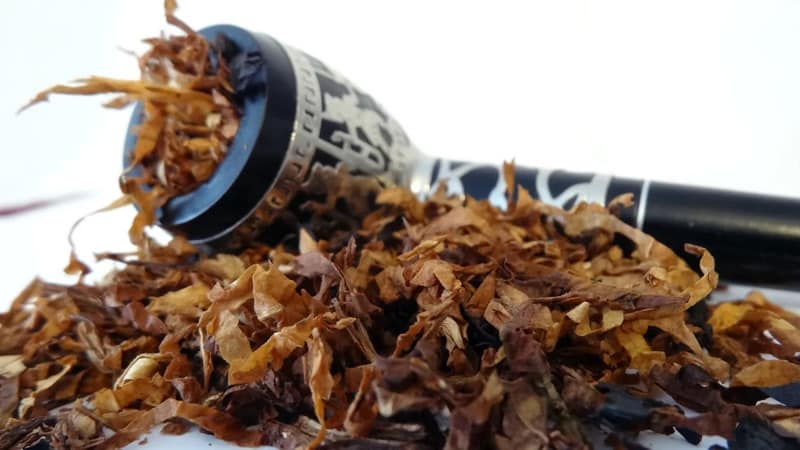
Reviews
Reviews of Turkish tobacco are mostly positive. Tobacco growers are happy to share their opinions about it:
Artem, Tambov: «I have always dreamed of growing tobacco products at home. I decided to start with Turkish. Everything worked out. The harvest was large, and caring for the plants took a minimum amount of time and effort. Drying and fermentation took place simultaneously under the sun. Very satisfied. Next year I’ll plant it again.”
Inna, Kazan: “I’ve been involved in tobacco growing for a long time, I’ve tried many crops. I like the Turkish variety the most. It does not require complex care, and the results are simply excellent. I recommend this crop to all lovers of quality products.”
Conclusion
Turkish tobacco has numerous advantages, the main ones of which are simple agricultural technology and high yield. The culture is able to withstand many dangerous diseases. But most of all, this plant is valued for its unusual chocolate flavor combined with thick white smoke.